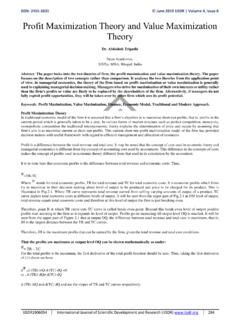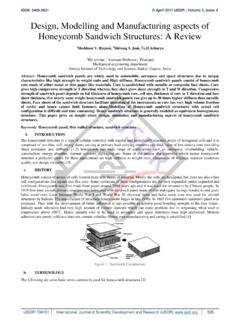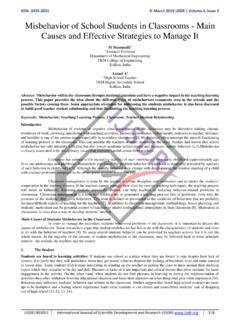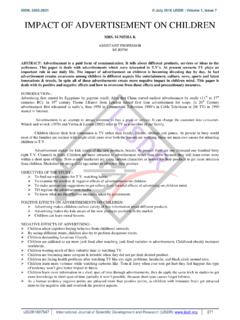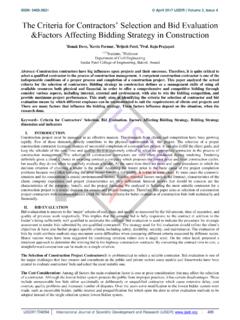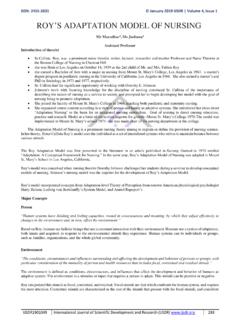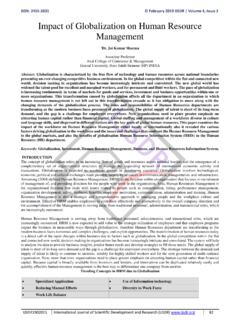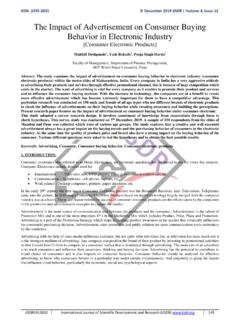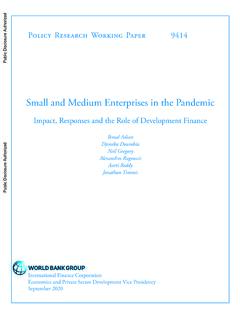Transcription of A study on impact of social media on small and Medium ...
1 ISSN: 2455-2631 November 2017 IJSDR | Volume 2, Issue 11. A study on impact of social media on small and Medium enterprises 1. , 2 Afraa Mahboob, 3 Ankita Choudhary 1. Assistant Professor, 2,3 Research Scholars Department of Commerce and Management Acharya Institute of Graduate Studies Bangalore- 560107. Abstract: The present paper briefly provides a literature based review of how the social media affects small and Medium sized enterprises in the Arab world. usage by small and middle-sized businesses is gaining prominence in the Arab region. The present paper sought to establish how the social media is influencing the small and Medium -sized businesses in the region, in general, as established by recent empirical research and theoretical scholarship. According to the review, there is unique relationship between the social media and SMEs in social , political, religious or cultural and economic spheres. This relationship has enabled the social media to uniquely impact on the Arabian market in such areas as offering (a) a marketing platform for the Information Age, (b) an avenue and forum for increased sales, (c) an innovative edge for SMEs to reduce expenditure/cost and increase profitability, and (d) a benchmark of direct client communication of modern PR.
2 Keywords: SMEs, social media , Innovation, Profitably, External factors. 1. Introduction. social media marketing is the latest "buzz" in marketing. India is probably among the first proponents of social media marketing. These days, the organizational cause has replaced the social cause as companies seek to engage with their audience via the online platforms. Online presence is a must for businesses today. Apart from a basic website; consumers looks for a blog, a Facebook page, shopping cart, e-brochures, etc. 92% of micro and small businessesagree that social media is an effective marketing technology tool. They are evenly split on the effectiveness of social media for attracting new customers and engaging existing customers. (e-Strategy Trends). Definitions of Micro, small & Medium Enterprises In accordance with the provision of Micro, small & Medium Enterprises Development (MSMED) Act, 2006 the Micro, small and Medium Enterprises (MSME) are classified in two Classes: 1.
3 Manufacturing Enterprises-he enterprises engaged in the manufacture or production of goods pertaining to any industry specified in the first schedule to the industries (Development and regulation) Act, 1951) or employing plant and machinery in the process of value addition to the final product having a distinct name or character or use. The Manufacturing Enterprise are defined in terms of investment in Plant & Machinery. 2. Service Enterprises:-The enterprises engaged in providing or rendering of services and are defined in terms of investment in The limit for investment in plant and machinery / equipment for manufacturing / service enterprises, as notified,vide 1642(E). are as under Manufacturing Sector Enterprises Investment in plant & machinery Micro Enterprises Does not exceed twenty five lakh rupees small Enterprises More than twenty five lakh rupees but does not exceed five crore rupees Medium Enterprises More than five crore rupees but does not exceed ten crore rupees Service Sector Enterprises Investment in equipments Micro Enterprises Does not exceed ten lakh rupees: small Enterprises More than ten lakh rupees but does not exceed two crore rupees Medium Enterprises More than two crore rupees but does not exceed five core rupees IJSDR1711013 International Journal of Scientific Development and Research (IJSDR) 64.
4 ISSN: 2455-2631 November 2017 IJSDR | Volume 2, Issue 11. Types of Micro and small Home-based businesses A home-based business is an enterprise in which all or most of the work is performed at or from the owner-operator's private residence. Home-based business is one of the fastest growing sectors in the economy. Common businesses that are operated from home are trade businesses, where general administrative tasks are done at home, with work being completed at various sites. Examples include painters, plumbers and electricians. Many micro-businesses are family operated. Family members will generally have ownership of the business and play a significant role in its day-to-day operations. Many publicly-listed companies and franchises started from the humble beginnings of a family-operated business. Some common examples of family businesses include cake shops, restaurants, caf , florists, designers, photography and so on.
5 Independent contractors run their own business, and hire out their time to businesses and other organisations as a service. Their entitlements and obligations differ from an employee in many ways. They own our own business and generally will be able to negotiate fees and working arrangements. Some examples of independent contractors are builders, caterers and personal trainers. A franchise is an arrangement whereby the originator of a business product or operating system (franchisor) gives a prospective small business owner (franchisee) the right to sell these products and/or use the business operations system on the franchisor's behalf. Some key micro-business franchises include food chains, cleaning businesses franchises. E-businesses are businesses that utilise the internet for business activities, advertising and transactions. With the increase in internet use and popularity, along with relatively low start-up capital requirements, the emergence of e-businesses has seen a dramatic increase in the past decade.
6 Some e-businesses are solely internet-based, with all communications and transactions completed online. Other businesses use a website to support the physical store and products, by providing product information online. Others simply use the internet as an advertising tool. Marketing The management process through which goods and services move from concept to the customer. Marketing is based on thinking about the business in terms of customer needs and their satisfaction. Marketing differs from selling because (in the words of Harvard Business School's retired professor of marketing Theodore C. Levitt) "Selling concerns itself with the tricks and techniques of getting people to exchange their cash for your product. It is not concerned with the values that the exchange is all about. And it does not, as marketing invariable does, view the entire business process as consisting of a tightly integrated effort to discover, create, arouse and satisfy customer needs.
7 " In other words, marketing has less to do with getting customers to pay for your product as it does developing a demand for that product and fulfilling the customer's needs. The marketing mix is a familiar marketing strategy tool, which you will probably know, was traditionally limited to the core 4Ps of Product, Price, Place and Promotion The 4Ps were designed at a time where businesses sold products, rather than services and the role of customer service in helping brand development wasn t so well know. Over time, Booms and Pitner added three extended service mix P s : Participants, Physical evidence and Processes, and later Participants was renamed People. Today, it s recommended that the full 7Ps of the marketing mix are considered when reviewing competitive strategies. Thus the businessman uses appropriate marketing mix for his product or services and prepare a marketing strategy using various combinations to reach out the customers.
8 Marketing Strategy An organization's strategy that combines all of its marketing goals into one comprehensive plan. A good marketing strategy should be drawn from market research and focus on the right product mix in order to achieve the maximum profit potential and sustain the business. The marketing strategy is the foundation of a marketing plan. Life for marketers used to be simpler. He just had a few TV channels, some radio stations, a handful of top magazines and a newspaper or two in each market. Reaching consumers was easy by crafting a compelling message. Now there are whole slew of TV channels, millions of web sites and hundreds of thousands of applications. Marketing was never easy, but technology has made it a whole lot tougher. What used to be a matter of identifying needs and communicating benefits now requires to build immersive experiences that engage consumers which requires a seamless integration of a whole new range of skills and capabilities.
9 There s so much going on in the marketing arena today, everybody is struggling to keep up. At the same time, every marketing professional feels pressure to be progressive and actively integrate emerging media into their marketing program. However, most businesses can be adequately captured by evaluating just three metrics: awareness, sales and advocacy ( customer referral). This metrics can be achieved through traditional media along with combination of new media called social media . social media and small Businesses social media Is Changing the Traditional methods of Presence. The traditional techniques of marketing using print and electronic media along with Internet marketing and lead generation were used to drive traffic to a business and its website. As search engine algorithms evolve, website owners have to stay on their toes to make sure their website is constantly updated with relevant and current information to prevent being devalued in search results.
10 Today, social media like, Facebook pages, Twitter accounts, and YouTube channels are being seen as sites in their own right to mark the presence. social media Allows Businesses to Crowd-source Ideas Before you launch a new product or service, one would like to have some ideas about what people think about it. So by engaging with prospects and customers via social media , one can actually ask the fans and followers what colors they prefer or what types of features they want. Thus one can involve consumers in valuable free market research, by asking their opinions and can help establish credibility by showing that Page | 32 their opinions matter. After seeing their ideas becoming a reality, business has more than likely just increased their customer base. social media Allows to Keep An Eye On Competition . Businesses are changing marketing strategies based on information they find in social media feeds from their competitors.
